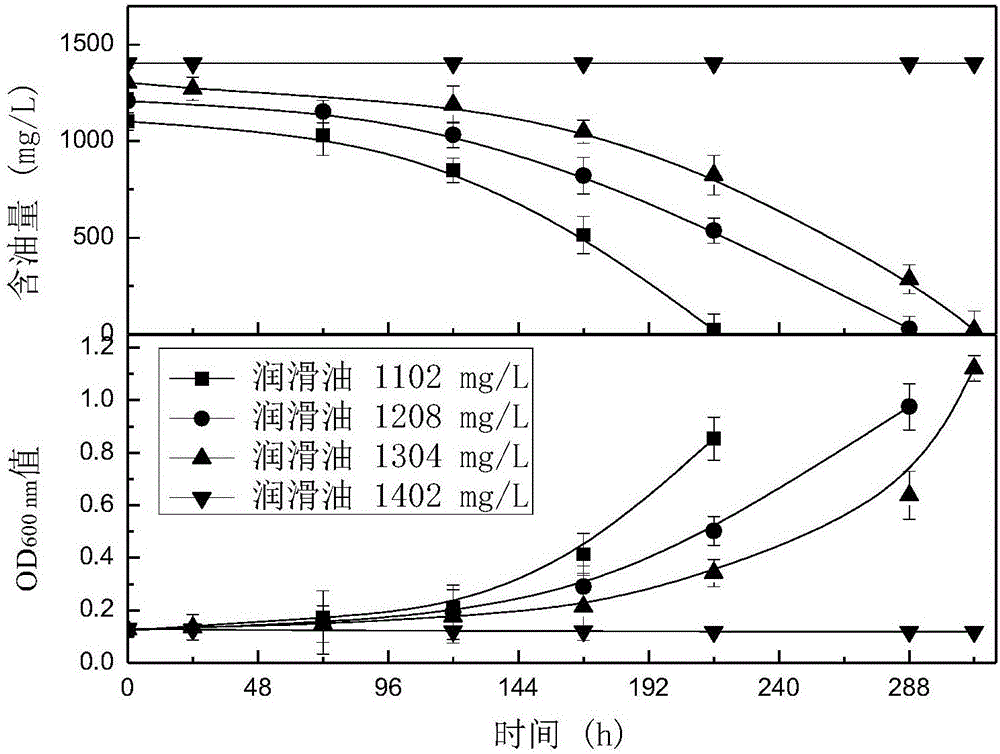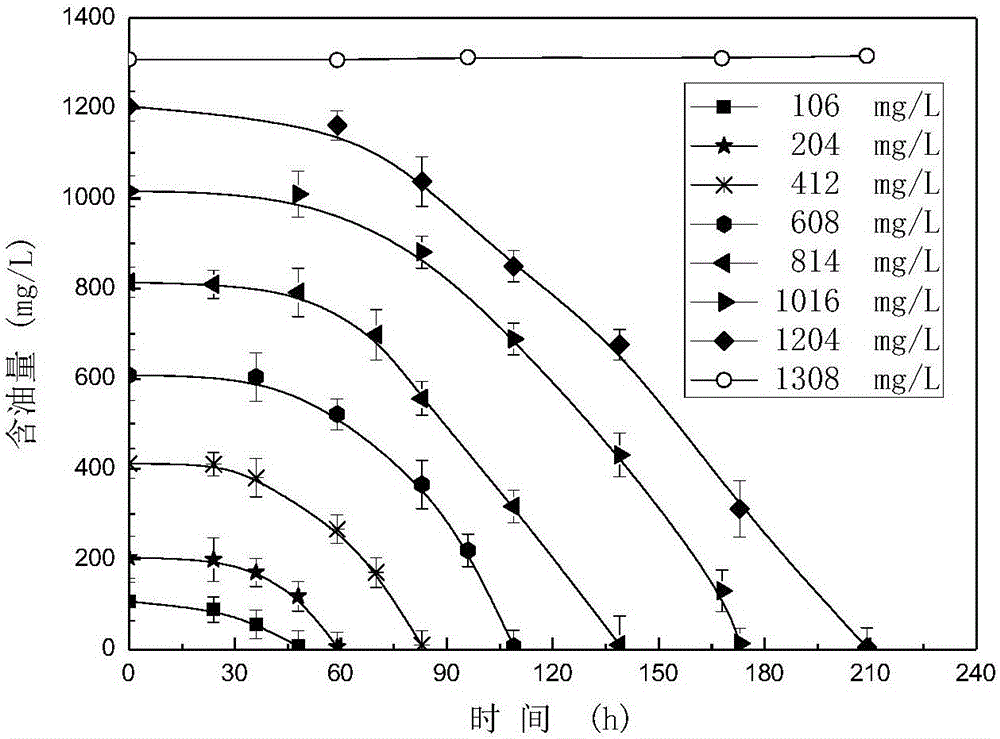Biological oil removal method for lubricating oil containing acid residues by using acidovorax avenae
A technology of oat acidophilus and biological oil removal, which is applied in chemical instruments and methods, biological water/sewage treatment, special compound water treatment, etc., can solve the problems that restrict the orderly development of waste oil regeneration industry, doubts about sulfuric acid-clay process, Deal with problems such as poor effect, achieve the effect of low processing cost, easy operation, and saving processing cost
- Summary
- Abstract
- Description
- Claims
- Application Information
AI Technical Summary
Problems solved by technology
Method used
Image
Examples
Embodiment 1
[0057] The method for biological degreasing of acid slag containing lubricating oil by using oat acidophilus comprises the following steps:
[0058] 1) Preparation of seed liquid: Inoculate oat acidophilus bacteria preserved on a slope into LB medium, and culture overnight for about 14 hours, as long as the culture liquid does not appear significantly turbid (generally OD 600nm =0.8-1.3); Inoculate into fresh LB medium with 0.5%-2% inoculum size for secondary activation culture, control the OD of the second generation culture solution 600nm =1.1-1.2, the second-generation culture solution is used as an inoculum to remove oil from acid residue; the whole culture process is cultivated on a shaking table at 35-37°C, 180rpm-200rom.
[0059] 2) Acid slag pretreatment: Spread the acid slag flat with a thickness of no more than 50cm, and evenly spray urea solution with a concentration of 3% (m / v) and 0.2mol / L dipotassium hydrogen phosphate solution on it, and the dosage is generally ...
Embodiment 2
[0062] Effects of different ratios of nitrogen and phosphorus nutrients on the effect of acid residue bioremoval.
[0063] Put about 4mL of secondary activated oat acidophilus fermentation liquid into the plastic culture cells labeled No. 1, No. 2, and No. 3 with about 50 g of acid slag, using urea as the nitrogen source and dipotassium hydrogen phosphate as the nitrogen source. Add nutrients to the phosphorus source according to the C:N:P ratio of 100:5:1, 100:10:1, and 100:15:1, and place it at 35°C for treatment. The plowing frequency is once every 24 hours. The water content of the acid residue is controlled at about 25%, and the oil content of the acid residue of the biologically treated waste lubricating oil refining acid residue is monitored at 7 days, 14 days, 21 days, and 30 days, and the degradation rate is calculated (oil removal rate in the figure).
[0064] Figure 8 It reflects the effect of using urea as the nitrogen source, dipotassium hydrogen phosphate as th...
Embodiment 3
[0066] Example of isothermal biological treatment under optimized conditions.
[0067]Inoculate about 4mL of oat acidophilus fermented broth after secondary activation into plastic culture grids labeled No. 1 and No. 2 with about 50 g of acid slag, using urea as nitrogen source and dipotassium hydrogen phosphate as phosphorus source, and C The ratio of :N:P is 100:15:1, the frequency of tillage is once every 12 hours, and the treatment is carried out at a constant temperature of 35°C. The water content of the acid slag is maintained at 30%, and the oat acidophilus is monitored at different treatment times. The oil content of the acid residue and calculate the degradation rate.
[0068] Figure 9 It reflects the biological oil removal of waste lubricating oil refining acid residue in a constant temperature environment of 35 °C. After 63 days of biological treatment, the acid residue with an initial oil content of 68.4 mg / g dropped to below 1 mg / g, and the biological oil remov...
PUM
 Login to View More
Login to View More Abstract
Description
Claims
Application Information
 Login to View More
Login to View More - R&D
- Intellectual Property
- Life Sciences
- Materials
- Tech Scout
- Unparalleled Data Quality
- Higher Quality Content
- 60% Fewer Hallucinations
Browse by: Latest US Patents, China's latest patents, Technical Efficacy Thesaurus, Application Domain, Technology Topic, Popular Technical Reports.
© 2025 PatSnap. All rights reserved.Legal|Privacy policy|Modern Slavery Act Transparency Statement|Sitemap|About US| Contact US: help@patsnap.com



